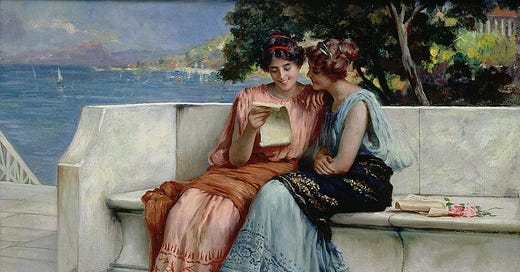One of my most frequently asked questions is how The Children’s Tradition differs from Ambleside Online. I suppose it is natural for anyone marketing a “Classical Charlotte Mason Curriculum'' to naturally beg the question of how much they were influenced by the OG Mason curriculum. I have tremendous respect for the AO Advisory and Auxiliary members and I am extremely grateful for the very good work they are doing in the world! Though we have different starting places and points of reference, there are naturally overlaps as we share a love of good, old books. Nevertheless, TCT and AO are two very distinct curricula, as I will explain, so let me dive in.
TCT is based on the work of John Senior and the Integrated Humanities Program of the University of Kansas in the 1980’s and then supplemented by my previous knowledge of the Great Tradition (of which Charlotte Mason is a part).
AO is solely based on the work of Charlotte Mason.
TCT begins with a theology of God, and deduces educational philosophy from those foundational theological principles. After clearly articulating the educational philosophy, I then give lesson plans that include philosophical explanations for each piece’s place in the curriculum and how we can approach it while maintaining the poetic mode of learning. Booklists and lesson plans come last.
AO begins by giving you lesson plans and booklists, and directs you to read Mason’s volumes to build out your philosophy.
TCT explicitly prioritizes the poetic mode of learning for every aspect of the curriculum.
AO could be done in the poetic mode, but this would need to be deduced from Mason’s philosophy because it is not explicitly taught, or at least not taught in a way that moderns will easily understand.
TCT reads through books at a faster pace, and for longer periods of time in a day (sometimes).
AO, in the tradition of Mason, emphasizes short lessons, at times taking multiple years to cover a book.
TCT does not follow a history cycle of any kind but rather includes biographies, autobiographies, and historical fiction to cultivate the imaginative sense of a child, building a world of history in their minds and a deep connection to individuals from the past as they spend time learning about a single historical person for several weeks. I also recommend the medieval Chroniclers, per Mason’s suggestion on pages 282-284 in Home Education.
AO follows a six year history cycle and uses a combination of history spines with biographies.
TCT puts a strong emphasis on fables, fairy tales, myths, and legends. We read them a lot, and we read them over and over again, year by year, in many versions. These are the very heart of the curriculum.
AO includes some fairy tales and fables in Year 1, with a book of myths beginning in third grade. Legends are sparse, but are there in places like the beginning of Island Story, for example.
TCT includes re-reading, hoping children will have encountered some of the key books multiple times in their childhood.
AO does not have any re-reading, though it does extend certain books across multiple years.
TCT includes all of the books on John Senior’s 1,000 Good Books list under nursery and school years in the lesson plans.
AO includes some of the books on John Senior’s 1,000 Good Books list, but this was not their point of reference.
TCT, while borrowing Mason’s categories of Knowledge of God, Man, and the Universe, does not teach subjects but rather aims to cultivate a child’s outer and inner senses. In doing so TCT is hearkening back to the classical idea of elementary education as gymnastic and musical education.
AO teaches subjects utilizing Mason’s framework that education is an atmosphere, a discipline, and a life.
TCT recommends a poetic approach to reading.
AO recommends a phonics-based approach to reading.
This is not a perfect or complete list, but I think it sufficiently shows that TCT stands on its own two feet as fully distinct from AO. I hope this list will be helpful and show those distinctions without dishonoring the very real blessing that AO has been to the homeschool world. I will conclude by adding that there are a number of mothers who are doing AO, but purchased TCT to help them sharpen their philosophy and to have a solid reference for any books that they might want to change out. I think that is wonderful! At the end of the day, I believe an education based off The Great Tradition is more philosophically sound than centering one individual as the reference point, but that in no way diminishes the love or respect I have for Mason educators, and any wonderful curriculums in that stream!
If you’d like to learn more about The Children’s Tradition you can visit our website or watch this video.
It is very likely that I improve and update this article later, so feel free to comment any questions, clarifications, or disagreements you may have. I welcome the dialogue!






Just as I would not feel comfortable teaching my children from the good and the beautiful written by a Mormon. I would feel the same knowing that the background of this Philosophy is Catholic. The CMEC also leans Catholic. Why are Protestants not upset about this. The reformation is not over! I think I’ll stick with AO which point my children to the gospel and not a false gospel of works.
I had listened to your interviews with Autumn and was drawn in to the philosophy. But, I was so curious about the differences since we’ve used AO for a few years now. Thank you for the explanation. Also, grateful for the comments/questions that I maybe hadn’t considered to ask. Looking forward to doing a little more research with your podcast episodes. Thank you!